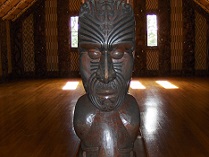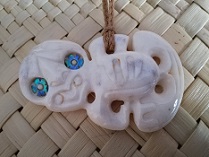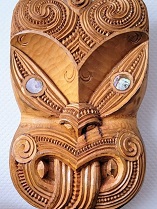Carving
 |
Whakairo - the Art of Carving
This is the general name for the Maori art of carving in several materials.
Whakairo Rakau – the Maori Art of Woodcarving..
For Bone and NZ Jade ( NZ Greenstone, Pounamu) carvings go to:
http://www.matariki.nl/Artefacts_e/Jewellery/Pendants/Bone/
http://www.matariki.nl/Artefacts_e/Jewellery/Pendants/Greenstone/

Maori Arts are the means of recording tribal history, acknowledging the spiritual world and illustrating Whakapapa (genealogy)
Spiritual world symbols are very well contained in the art form Whakairo , which means carving.
Carving is believed by many to represent the ultimate indigenous art form of New Zealand.
Quality carvings pay deep respect to ancestors, history, myths and legends.
Although Maori did not develop an alphabet type of reading and writing until after the white man came, they had a highly developed reading and writing style within carving. Today people can read A B C, but the art of reading carving is still alive.
This is the Maori recorded history, handed down to Maori people through the passages of time. There are carvings that are over 500 years old still surviving today, yet historians prefer to read what is written in books, often by people who are not Maori, instead of taking the time to read history as recorded by the Maori, which I personally find much more interesting.
The story of the discovery of Whakairo from under the sea is famous in Māori tradition. It tells of the imprisonment of Te Manuhauturuki, the son of Ruatepupuke. Te Manu was captured by Tangaroa, taken to his house deep in the ocean, and mounted on the gable. Ruatepupuke undertook the journey to find his son.
The legends tell that Ruatepupuke visited Tangaroa’s whare beneath the sea and there saw that the poupou, the supporting boards of the whare walls were carved and were also human figures and that they could speak.
Ruatepupuke stole the poupou, the carved posts, took them back to his world but they lost the ability to speak.
Their very presence however were a guide to the future tohunga whakairo , the master carvers.

The distinctive differences in New Zealand Maori carving owe much to the isolation of the Maori from the rest of Polynesia over many centuries. Also an abundance of timber such as kauri and totara provided a perfect medium for the art. The traditional carving tools such as chisels and adzes could be made by the ample supply of Greenstone (Pounamu).
The greatest advantage for the art of the carver came with the introduction of steel tools in the late eighteenth and early nineteenth centuries.
The art of Whakairo is now thriving.
The Maori Kaiwhakairo ( carvers) of these days are very professional artists. Many of them have attended Te Wananga Whakairo, the carving school, where they have learned the magnificent traditions and methods of the Maori craft of Whakairo. A constant stream of qualified carvers trained by masters craftsmen are emerging to carry their skills back to the people troughout the country.
Maori Whare nui ( meeting houses) today are ( with some exceptions) carved works of art.
The names of the carved figures and the carved symbols contain the history of the Iwi that belong to the Whare.
The Whare whakairo, carved houses are decorated with carved Amo (bargeboards) and Poupou( panels or posts).
At the apex of the Amo on the outside of the Whare is the Tekoteko, a carved figure or head.
The bases of the supporting ridgepole are Poupou, which are round and often with the whole circumference carved.

There are some forms that recur in the various forms of Maori art and are also very common forms in whakairo.
The dominant figure of Maori carving is the human figure, portrayed in varying form.
The face often with protruding tongue, appears both in full face and in profile.
There are four main types of heads in Maori carving, the Wheku, the Ruru, the Koruru and the human head.
The profile is sometimes distorted and becomes the Manaia form.
The Manaia is the spirit that each person has.
It is protective of its human subject and at the appointed time, the Manaia will guide the spirit of the deceased human to the departure place for the spirit world.
The carved form of the Manaia usually has three fingers representing birth, life and death, also the head of a bird which symbolizes flight.
Some Maori believe that the three fingers represent the three kete of knowledge.
The Koru – the unfolding fern frond illustrates the life cycle of man. The different forms of the koru trace the life cycle from the time in the womb to the time of old age.
The Kowhaiwhai These are repeatedly used decorative patterns that are used in carving as well as painting.
They all have separate meanings and names. To have a look at those patterns see page Symbolism.
Please feel free to enter the button(s) above where you will find the profile of carvers and their artworks of Whakairo.
If you want more information, a noncommittal quote or information about exhibitions, please use info@matariki.nl

















